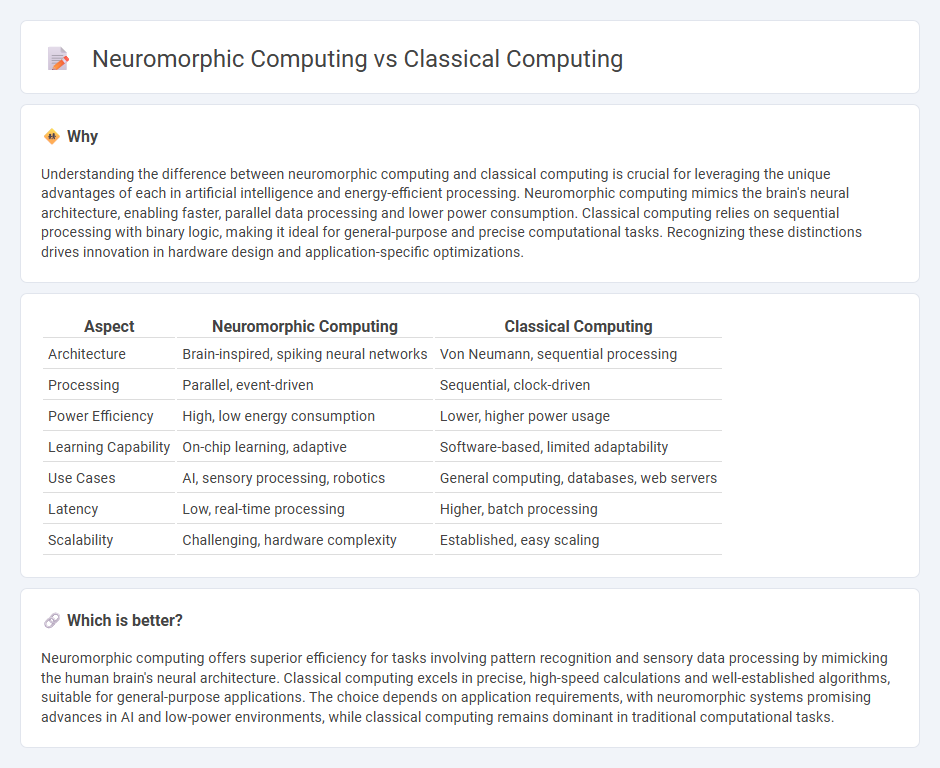
Neuromorphic computing mimics the human brain's neural architecture to achieve energy-efficient and parallel data processing, contrasting with classical computing's sequential processing based on binary logic. This approach enables faster pattern recognition and adaptive learning, ideal for AI and sensory applications, while classical systems excel in precision and established programming paradigms. Explore how neuromorphic technology is reshaping the future of computing and artificial intelligence.
Why it is important
Understanding the difference between neuromorphic computing and classical computing is crucial for leveraging the unique advantages of each in artificial intelligence and energy-efficient processing. Neuromorphic computing mimics the brain's neural architecture, enabling faster, parallel data processing and lower power consumption. Classical computing relies on sequential processing with binary logic, making it ideal for general-purpose and precise computational tasks. Recognizing these distinctions drives innovation in hardware design and application-specific optimizations.
Comparison Table
| Aspect | Neuromorphic Computing | Classical Computing |
|---|---|---|
| Architecture | Brain-inspired, spiking neural networks | Von Neumann, sequential processing |
| Processing | Parallel, event-driven | Sequential, clock-driven |
| Power Efficiency | High, low energy consumption | Lower, higher power usage |
| Learning Capability | On-chip learning, adaptive | Software-based, limited adaptability |
| Use Cases | AI, sensory processing, robotics | General computing, databases, web servers |
| Latency | Low, real-time processing | Higher, batch processing |
| Scalability | Challenging, hardware complexity | Established, easy scaling |
Which is better?
Neuromorphic computing offers superior efficiency for tasks involving pattern recognition and sensory data processing by mimicking the human brain's neural architecture. Classical computing excels in precise, high-speed calculations and well-established algorithms, suitable for general-purpose applications. The choice depends on application requirements, with neuromorphic systems promising advances in AI and low-power environments, while classical computing remains dominant in traditional computational tasks.
Connection
Neuromorphic computing mimics the neural architecture of the human brain, enhancing classical computing by enabling more efficient processing of complex, unstructured data such as sensory inputs. Classical computing relies on deterministic algorithms and sequential processing, while neuromorphic systems use parallelism and event-driven architectures to improve energy efficiency and real-time decision-making. Integrating neuromorphic chips with conventional processors creates hybrid platforms that leverage the strengths of both, advancing AI applications and cognitive computing.
Key Terms
Von Neumann Architecture
Classical computing relies on the Von Neumann architecture, which separates memory and processing units, leading to bottlenecks in data transfer and limiting efficiency. Neuromorphic computing mimics neural networks with distributed memory and processing, enabling parallelism and low power consumption, addressing the limitations of Von Neumann design. Explore more to understand how neuromorphic systems can revolutionize computing beyond traditional architectures.
Spiking Neural Networks
Classical computing relies on binary logic gates and sequential processing, whereas neuromorphic computing, inspired by brain architecture, uses Spiking Neural Networks (SNNs) that encode information through discrete spike timings, enabling energy-efficient and parallel data processing. SNNs mimic neural activity by transmitting information via spikes, offering advantages in real-time pattern recognition and adaptability over traditional artificial neural networks in classical systems. Explore the emerging applications and breakthroughs in neuromorphic hardware and SNN algorithms to understand the future of computing paradigms.
Parallelism
Classical computing relies on sequential processing, executing instructions one after another or through limited parallelism using multi-core architectures. Neuromorphic computing mimics the brain's neural networks, enabling massive parallel processing by simulating interconnected neurons and synapses simultaneously. Explore how this revolutionary approach transforms complex data processing and enhances computational efficiency.
Source and External Links
What is classical computing? | Definition from TechTarget - Classical computing, or binary computing, is a traditional method where information is stored as bits representing 0 or 1 and operations are deterministic and based on Boolean algebra, differing fundamentally from quantum computing which uses qubits and quantum mechanics.
Quantum Computing vs Classical Computing - Berkeley Nucleonics - Classical computers process data using bits with linear scalability in calculations and rely on human programming without intrinsic intelligence, contrasting with quantum computers' exponential calculation capacity due to qubits.
II Classical computation*> PHYS483 - Lancaster University - Classical computers use the von Neumann architecture, storing and processing binary information as bits (0 or 1) which can represent various data types through sequences, with information transmission described through statistical mechanics.
 dowidth.com
dowidth.com